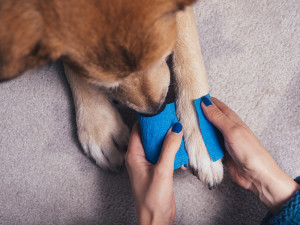How to Treat a Bladder Infection in Dogs
It’s not fun for anyone.

Share Article
In This Article:
How to Tell If Your Dog Has a Bladder Infectionopens in a new tab Can You Inspect Your Dog’s Urine for Signs of a Bladder Infection?opens in a new tab Conditions That Predispose Dogs to Bladder Infectionsopens in a new tab Is Your Dog’s Bladder Infection Serious?opens in a new tab
Just when you thought your dog’s house training daysopens in a new tab were behind you, and you could rely on your pup to make it outside to pee, they suddenly start having accidents out of the blue. Is it a behavior regression or could it be a sign of a bladder infection? Bladder infections, also known as bacterial cystitis, or urinary tract infections (UTIs) affect about 14 percent of dogs.
Common signs of a bladder infection in dogs include frequent urination, straining to urinate, blood in their urine, or whimpering during urination. Dogs may also display increased thirst, have accidents in the house, have strong-smelling urine, and/or excessively lick their genital area. Some dogs become lethargic, show other signs of discomfort, or even have a fever. Many of these signs can also occur with other serious medical conditions so it is important to have your pup seen by a vet right away if they have any of them.

Get (totally free) deals for food, treats, accessories, tech, and way more pet parenting must-haves.
opens in a new tabHow to tell if your dog has a bladder infection
Often, the first signs of a bladder infection are changes in a dog’s urinary patterns. You may also notice other physical and behavioral signs including:
Bladder infection symptoms
Frequent urination: dogs with bladder infections often need to urinate more oftenopens in a new tab and with urgency.
Accidents in the house: Due to the urgency and the frequent need to pee, they may have urinary accidents indoors even when they are typically well potty trainedopens in a new tab.
Increased water consumption: Dogs with UTIs may drink more wateropens in a new tab to keep up with their hydration since they are peeing more often.
Straining to pee: UTIs cause inflammation within the urinary tract so dogs often feel like they have to pee due to that irritation, even if their bladder is empty. This sensation leads them to strain to pee.
Whimpering when urinating: The inflammation within their urinary tract is painful and some dogs may whimperopens in a new tab while trying to pee or even before and after urinating.
Excessive licking after peeing: Dogs often lick to try to soothe painful areas and they may lick at their bellies or genital region due to painful urination.
Discolored urine: Dogs with UTIs often have changes in their urine including a cloudy appearance, urine that is darker than normal, or bloody. Sometimes this can be nearly impossible to see if your dog is urinating in the grass, however.
Can you inspect your dog’s urine for signs of a bladder infection?
While there are some visible changes you can see in your dog’s urine, the only way to confirm a bladder infection is with a urinalysis performed at your veterinary clinic. This test allows microscopic analysis of a urine sample to detect signs of an infection that are not visible to the naked eye. Some of the changes you might see include:
What to look for in your dog’s urine
Reduced volume: Dogs who are peeing frequently due to discomfort will urinate smaller amounts each time.
Blood in urine: Sometimes you may see obvious blood in the urine when a dog has a UTI; however, other times only microscopic amounts of blood are present.
Strong odor: Often bladder infections cause a bad odor to the urine, but this is not always the case.
Cloudy urine: Urine may have a more opaque or cloudy appearance when there is a bladder infection. This can be difficult to observe if your dog is peeing outdoors.
Conditions that predispose dogs to bladder infections
Bladder infections can happen for many different reasons and there is not always a clear underlying condition that leads to them. The majority of bladder infections in dogs are caused by bacteria, although occasionally dogs can have viral or fungal infections as well. Certain underlying conditions are associated with bladder infections so it is important to check for these, especially in dogs with recurring UTIs. This includes:
Conditions that predispose dogs to bladder infection
Bladder stones: There are many different types of bladder stones caused by different biological processesopens in a new tab. All bladder stones are very irritating to the lining of the bladder and can cause repeated trauma which can make the bladder more vulnerable to infections.
Kidney disease: Kidney diseaseopens in a new tab causes the urine to be more dilute than normal, which allows bacteria to grow more easily and puts dogs at risk for infections.
Diabetes: Diabetes also causesopens in a new tab the urine to be more dilute as well as to contain abnormal amounts of sugar, both of which can create a welcoming environment for bacteria to grow.
Tumors or bladder cancer: Cancer within the bladderopens in a new tab or anywhere in the urinary tract can disrupt the body’s natural defenses against infection and make dogs more likely to develop UTIs.
Prostate issues: Prostate infections, an enlarged prostate, or even prostatic cancer can also disrupt the normal defenses to bladder infections and are a good reason to neuter male dogsopens in a new tab.
Hormone imbalances: Other hormone imbalances including Cushing’s diseaseopens in a new tab and certain steroid medications also cause dilute urine and suppress the immune system, which can predispose dogs to bladder infections.
Anatomy: Abnormal anatomy such as a hooded vulva or ectopic ureters can also create environments that favor bacteria and put dogs at risk for UTIsopens in a new tab.
Is your dog’s bladder infection serious?
Bladder infections should always be taken seriously and always warrant a trip to the vet. Not only are they very painful and distressing to your pup, but they can snowball into life-threatening problems, including kidney infections known as pyelonephritis and/or systemic infections, known as sepsis.
Additionally, there are other serious health problems that can have a lot of the same signs as a UTI, so it is very important to get an accurate diagnosis from a vet and treat your pup appropriately. Be sure to follow all of your vet’s recommendations and finish all medications as directed.
When to consult a vet
Any signs or symptoms of a urinary problem: It is always necessary to have your dog checked out by a vet when they start showing changes in their urinary habits. In addition to UTIs, changes in urination can also be associated with other serious medical problems.
Dog demonstrates pain: Any dog showing signs of painopens in a new tab should see a vet promptly to get relief as well as get to the bottom of what’s causing their pain.
Evidence of bleeding: Blood in the urine or any unknown cause for bleeding is always a sign to seek veterinary care for your pup.
Prolonged lethargy: If your dog is suddenly sleeping all the time, hiding, unwilling to play or go for walks, something is upopens in a new tab, and it’s worth a trip to the vet.
Changes in appetite: Dogs who are sick or in pain may have a decreased appetite or skip meals altogether. This is especially concerning if your pup is normally a chowhound and is a clear sign that they aren’t feeling well.
Bottom line
Dogs with bladder infections can have many different symptoms.
If your dog has had repeated UTIs it is especially important to have them checked for predisposing factors that may be leading to repeat infections.
If you suspect your dog has a bladder infection, see a vet right away to avoid more serious complications.
References
Bloch, Rebecca, et al. “Veterinary antimicrobial prescribing practices for treatment of presumptive sporadic urinary tract infections in dogs examined at primary care practices in the United States (2010–2019)opens in a new tab.” Journal of the American Veterinary Medical Association, vol. 260, no. S2, 21 May 2022.
Brown, Scott. “Bacterial cystitis in small animalsopens in a new tab.” Merck Veterinary Manual, 2015.
Olin, Shelly, et al. “Urinary tract infectionsopens in a new tab.” Veterinary Clinics: Small Animal Practice, vol. 45, no. 4, July 2015, pp. 721-746.

Dr. Amy Fox, DVM
Amy Fox, DVM is a small animal veterinarian in New York City. A lifelong animal lover, Dr. Fox studied biology in college and then worked as a veterinary nurse before pursuing veterinary school at Cornell University. She has worked in many different settings including shelter medicine, emergency medicine, general practice, and animal cruelty and forensics. She is especially interested in nutrition, preventative medicine and care for senior pets. Dr. Fox also enjoys writing about veterinary medicine and teaching. In her free time she loves to cook, garden, and go for long runs.
Related articles
- opens in a new tab
Why Does My Dog Pee When Excited? Experts Explain What to Do About It
You’re happy to see them, too. But you’d be even happier if they didn’t create a mess.
![Woman adjusting the diaper on her small black dog.]() opens in a new tab
opens in a new tabHow to Get Your Dog to Wear a Diaper
And why they might need one.
![Woman with her dog relaxing in living room.]() opens in a new tab
opens in a new tabHow to Tell If Your Dog Is Sick
Look out for these warnings signs so you know when to call the vet.
![bandaging dog's bleeding paw]() opens in a new tab
opens in a new tabHow to Care for Your Bleeding Dog
Don’t freak out—here’s what to do.
- opens in a new tab
Why Does My Dog Smell Like Fish?
It’s not a very pleasant odor, to say the least.
- opens in a new tab
Why Is My Dog Peeing Blood?
That can’t be good...







